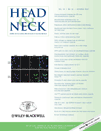Multimodality treatment for sinonasal neuroendocrine carcinoma
Abstract
Background
Neuroendocrine carcinoma (NEC) of the paranasal sinuses is rare, accounting for 5% of sinonasal malignancies. The purpose of this study was to assess prognostic factors and survival rates for sinonasal NEC.
Methods
A retrospective review of patients with NEC treated from 1990 to 2004 was performed. Patient demographics, TNM classification, treatment modality, recurrences, and survival were evaluated.
Results
NEC was identified in 28 patients; the most common primary site was the ethmoid sinuses. Most patients presented with advanced tumors; few had regional or distant metastasis. Local recurrence rate was 21%. Five-year overall survival (OS) and disease-specific survival (DSS) rates were 65% and 78%, respectively. Response to chemotherapy predicted for improved survival, although no differences in outcomes were noted between definitive management strategies.
Conclusion
NEC of the paranasal sinuses is an exceedingly rare malignancy of the paranasal sinuses. Our data suggests definitive management with surgery or radiotherapy offers durable control. The response to chemotherapy may predict for overall outcomes. © 2011 Wiley Periodicals, Inc. Head Neck, 2011




